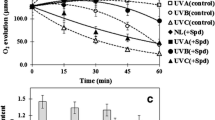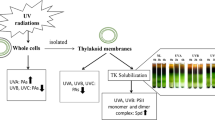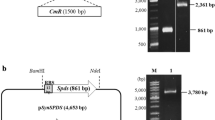Abstract
Common polyamines, putrescine (Put), spermidine (Spd), and spermine (Spm), are cationic compounds known as beneficial factors for many cellular processes including cell division, proliferation, differentiation, and stress response in all living organisms. Effects of exogenous Spm on the protective responses of Synechocystis sp. PCC 6803 exposed to UVA were investigated. The presence of 0.5 mM Spm in the culture medium significantly reduced cell growth after 60 min under white light condition but protected the cells after growing for 60 min under UVA. The stress-tolerant response of Synechocystis cells represented by the ratio of putrescine/spermidine (Put/Spd) showed about a 6-fold increase after 60 min UVA in the presence of Spm. In addition, those levels of chlorophyll a, carotenoids, and photosynthetic oxygen evolution were increased by Spm supplementation in UVA-treated cells. Exogenous Spm induced the activity of catalase but not superoxide dismutase in cells under UVA treatment. On the other hand, Spm treatment enabled cells to apparently decrease the intracellular free radical H2O2 and malonaldehyde (MDA) levels. Overall results suggested that Spm supplementation could protect Synechocystis sp. PCC 6803 cells via the increase of Put/Spd ratio and the reduction of both H2O2 and MDA levels in conjunction with the induction of catalase activity. Interestingly, UVA-treated cells as compared to non-treated cells with exogenous Spm showed a decrease of Spm with an increase of Put and no change in Spd. This suggested the back conversion of Spm to Spd and finally to Put as cellular mechanism in response to UVA.




Similar content being viewed by others
References
Beauchamp C, Fridovich I (1971) Superoxide dismutase: improved assays and an assay applicable to acrylamide gels. Anal Biochem 44:276–278
Bestfort RT, Richardson CM, Campos JL, Tiburcio AF (1993) Effect of polyamines on stabilization of molecular-complexes in thylakoid membranes of osmotically stressed oat leaves. Planta 189:201–206
Bradford MM (1976) Rapid and sensitive method for the quantitation of microgram quantities of protein utilizing the principle of protein-dye binding. Anal Biochem 72:248–254
Borrell A, Carbonell L, Farra’s R, Puıng-Parallada P, Tıburcio AF (1997) Polyamines inhibit lipid peroxidation in senescing oat leaves. Physiol Plant 99:385–390
Cadet J, Douki T, Ravanat J-L, Di Mascio P (2009) Sensitized formation of oxidatively generated damage to cellular DNA by UVA radiation. Photochem Photobiol Sci 8:903–911
Cao W, Liu G, Fang T, Wu X, Jia G, Zhao H, Chen X, Wu C, Wang J, Cai J (2015) Effects of spermine on the morphology, digestive enzyme activities, and antioxidant status of jejunum in suckling rats. RSC Adv 5:76607–76614
Chamovitz D, Sandmann G, Hirschberg J (1993) Molecular and biochemical characterization of herbicide-resistant mutants of cyanobacteria reveals that phytoene desaturation is a rate-limiting step in carotenoid biosynthesis. J Biol Chem 268:17348–17353
Dhindsa RS, Plumb-Dhindsa P, Thorpe TA (1981) Leaf senescence: correlated with increased levels of membrane permeability and lipid peroxidation and decrease levels of superoxide dismutase and catalase. J Exp Bot 32:93–101
Evans PT, Malmberg RL (1989) Do polyamines have roles in plant development? Ann Rev Plant Physiol Mol Biol 40:235–269
Flores ME, Galston AW (1982) Analysis of polyamines in higher plants by high performance liquid chromatography. Plant Physiol 69:701–706
Groppa MD, Benavides MP (2008) Polyamines and abiotic stress: recent advances. Amino Acids 34:35–45
Ha HC, Sirisoma NS, Kuppusamy P, Zweier JL, Woster PM, Casero RA Jr (1998) The natural polyamine spermine functions directly as a free radical scavenger. Proc Natl Acad Sci U S A 95:1140–11145
Heath RL, Packer L (1968) Photoperoxidation in isolated chloroplasts. I. Kinetics and stoichiometry of fatty acid peroxidation. Arch Biochem Biophys 125:189–198
Huang JJ-H, Cheung PC-K (2011) +UVA treatment increases the degree of unsaturation in microalgal fatty acids and total carotenoid content in Nitzschia closterium (Bacillariophyceae) and Isochrysis zhangjiangensis (Chrysophyceae). Food Chem 129:783–791
Ioannidis NE, Kotzabasis K (2007) Effects of polyamines on the functionality of photosynthetic membrane in vivo and in vitro. Biochim Biophys Acta 1767:1372–1382
Jana S, Choudhuri MA (1982) Glycolate metabolism of three submersed aquatic angiosperms during ageing. Aqua Bot 12:345–354
Jantaro S, Mäenpää P, Mulo P, Incharoensakdi A (2003) Content and biosynthesis of polyamines in salt and osmotically stressed cells of Synechocystis sp. PCC 6803. FEMS Microbiol Lett 228:129–135
Jantaro S, Pothipongsa A, Khanthasuwan S, Incharoensakdi A (2011) Short-term UV-B and UV-C radiations preferentially decrease spermidine contents and arginine decarboxylase transcript levels of Synechocystis sp. PCC 6803. Curr Microbiol 62(2):420–426
Jantaro S, Baebprasert W, Piyamawadee C, Sodsuay O, Incharoensakdi A (2014) Exogenous spermidine alleviates UV-induced growth inhibition of Synechocystis sp. PCC 6803 via reduction of hydrogen peroxide and malonaldehyde levels. Appl Biochem Biotechnol 173:1145–1156
Joshi PN, Ramaswamy NK, Raval MK, Desai TS, Nair PM, Biswal UC (1997) Response of senescing leaves of wheat seedlings to UVA radiation: inhibition of PSII activity in light and darkness. Environ Exper Bot 38:237–242
Liang Y, Beardall J, Heraud P (2006) Effects of nitrogen source and UV radiation on the growth, chlorophyll fluorescence and fatty acid composition of Phaeodactylum tricornutum and Chaetoceros muelleri (Bacillariophyceae). J Photochem Photobiol B Biol 82:161–172
Liu G, Fang T, Yan T, Jia G, Zhao H, Chen X, Wu C, Wang J (2014) Systemic responses of weaned rats to spermine against oxidative stress revealed by a metabolomic strategy. RSC Adv 4:56766–56778
Lütz C, Navakoudis E, Seidlitz HK, Kotzabasis K (2005) Simulated solar irradiation with enhanced UV-B adjust plastid- and thylakoid-associated polyamine changes for UV-B protection. Biochim Biophys Acta 1710:24–33
Moran R (1982) Formulae for determination of chlorophyllous pigments extracted with N,N-dimethylformamide. Plant Physiol 69:1376–1381
Pál M, Szalai G, Janda T (2015) Speculation: polyamines are important in abiotic stress signaling. Plant Sci 237:16–23
Pezzoni M, Pizarro RA, Costa CS (2014) Protective role of extracellular catalase (KatA) against UVA radiation in Pseudomonas aeruginosa biofilms. J Photochem Photobiol B Biol 131:53–64
Raksajit W, Yodsang P, Mäenpää P, Incharoensakdi A (2009) Characterization of spermidine transport system in a cyanobacterium Synechocystis sp. PCC 6803. J Microbiol Biotechnol 19:447–454
Rastogi RP, Madamwar D, Incharoensakdi A (2015) Multiple defense systems in cyanobacteria in response to solar UV radiation. Cyanobacteria: ecological importance, biotechnological uses and risk management. Douglas Davison (Ed.). Nova Science Publishers, Inc. New York
Rastogi RP, Incharoensakdi A, Madamwar D (2014) Responses of a rice-field cyanobacterium Anabaena siamensis TISTR-8012 upon PAR and UV radiation. J Plant Physiol 171:1545–1553
Samasil K, de Carvalho L, Mäenpää P, Salminen TA, Incharoensakdi A (2017) Biochemical characterization and homology modeling of polyamine oxidase from cyanobacterium Synechocystis sp. PCC 6803. Plant Physiol Biochem 119:159–169
Schweikert K, Burritt DJ (2015) Polyamines in microalgae: advances and future perspectives. J Phycol 51:838–849
Singh SP, Klisch M, Sinha RP, Häder DP (2010) Genome mining of mycosporine-like amino acid (MAA) synthesizing and non-synthesizing cyanobacteria: a bioinformatics study. Genomics 95:120–128
Stapleton AE (1992) Ultraviolet radiation and plants: burning questions. Plant Cell 4:1353–1358
Todorova D, Katerova Z, Shopov E, Nikolova A, Georgieva N, Sergiev I, Mapello S (2013) Polyamine spermine protects young pea plants against ultraviolet-C radiation. Biotechnol Biotechnol Equip 27:3796–3802
Unal D, Tuney I, Sukatar A (2008) The role of external polyamines on photosynthetic responses, lipid peroxidation, protein and chlorophyll a content under the UV-A (352 nm) stress in Physcia semipinnata. J Photochem Photobiol B Biol 90:64–68
White AL, Jahnke LS (2002) Contrasting effects of UV-A and UV-B on photosynthesis and photoprotection of β-carotene in two Dunaliella spp. Plant Cell Physiol 43:877–884
Wu X, Cao W, Jia G, Zhao H, Chen X, Wu C, Tang J, Wang J, Liu G (2017) New insights into the role of spermine in enhancing the antioxidant capacity of rat spleen and liver under oxidative stress. Anim Nutr 3:85–90
Vassilakaki M, Pflugmacher S (2008) Oxidative stress response of Synechocystis sp. (PCC 6803) due to exposure to microcystin-LR and cell-free cyanobacterial crude extract containing microcystin-LR. J Appl Phycol 20:219–225
Funding
S.J. received research funds from the Faculty of Science, CU (A1B1-NS), Chulalongkorn University and the Graduate School of Chulalongkorn University provided post-doctoral fellowship to W.B. The work is financially supported by the Commission on Higher Education, Thailand (WCU-013-FW-57), by Chulalongkorn University (RES560530052-FW), and by Thailand Research Fund (IRG 5780008) to A.I.
Author information
Authors and Affiliations
Corresponding author
Ethics declarations
Conflict of interest
The authors declare that they have no conflict of interest.
Informed consent
Informed consent is not required in this study.
Research involving human participants and/or animals
This article does not contain any studies with human participants or animals performed by any of the authors.
Rights and permissions
About this article
Cite this article
Jantaro, S., Baebprasert, W. & Incharoensakdi, A. External spermine prevents UVA-induced damage of Synechocystis sp. PCC 6803 via increased catalase activity and decreased H2O2 and malonaldehyde levels. Ann Microbiol 68, 697–704 (2018). https://doi.org/10.1007/s13213-018-1376-5
Received:
Accepted:
Published:
Issue Date:
DOI: https://doi.org/10.1007/s13213-018-1376-5




